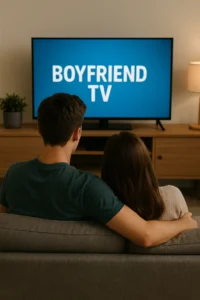Introduction: What is “Boyfriend TV”?
The digital world keeps inventing new spaces where entertainment, lifestyle, and relationships intersect. One emerging term gaining attention is “Boyfriend TV.” While it might sound like just another streaming service, it actually refers to a broader cultural idea: media and digital platforms that mirror relationships, intimacy, and emotional storytelling.
Much like how Netflix became synonymous with streaming, Boyfriend TV is used to describe a niche of online entertainment that reflects relationship dynamics, romance, and community engagement.
The Rise of Relationship-Centered Streaming
In the last decade, streaming platforms have shifted from mass media toward personalized experiences. Viewers today want stories that feel close to home, reflecting their emotions and connections.
Boyfriend TV represents this shift by offering:
- Romantic & emotional narratives
- Reality shows and dating series that focus on intimacy
- Music-driven content (playlists, shows, live sessions) tied to relationships
- Community engagement in forums, blogs, and platforms
According to a Pew Research Center report (2023), over 60% of adults aged 18–34 consume digital media specifically looking for relationship or lifestyle-focused content.
Why the Concept of “Boyfriend TV” Resonates
There are several reasons why Boyfriend TV as a trend works so well:
- Emotional Appeal – It focuses on human emotions, romance, and social bonds.
- Targeted for Gen Z & Millennials – Young viewers are shaping digital consumption, and they prefer authentic, relatable content.
- Cross-platform engagement – Boyfriend TV lives not only on streaming sites but also across YouTube, Spotify, Instagram, and TikTok.
For example, Spotify artists like Boyfriend TV build a multi-platform identity by blending music with digital storytelling.
Streaming Meets Music: Boyfriend TV in Pop Culture
One of the most exciting aspects of Boyfriend TV is its connection with music. Many new digital creators and artists label their projects under this term to signal relatability and intimacy in storytelling.
Much like K-drama fandoms or relationship-driven reality shows, Boyfriend TV combines:
- Visual streaming (shows, vlogs, series)
- Audio streaming (music, podcasts)
- Interactive media (fan chats, comments, forums)
This multi-layered approach reflects how audiences today want to consume and participate in media, not just watch passively.
Boyfriend TV as a Lifestyle
Beyond just media, Boyfriend TV can be seen as a lifestyle identity. It represents:
- Romantic escapism through series or music
- Comfort media – content people watch/listen to unwind or feel less lonely
- Community building around shared emotional experiences
Websites like RankRise1.com often highlight how digital culture evolves through SEO-driven communities, and Boyfriend TV is an example of a niche keyword turning into a cultural wave.
Criticism and Challenges
Like any trend, Boyfriend TV is not without criticism. Some concerns include:
- Over-commercialization of intimacy in media
- Idealized relationships that may not reflect reality
- Algorithmic push – audiences may feel trapped in niche content bubbles
A 2024 article in The Atlantic argued that “relationship-based digital entertainment often risks packaging human intimacy into overly simplified tropes.”
Real-World Relevance: LGBTQ+ and Inclusive Media
One powerful element of Boyfriend TV is how it has expanded inclusivity. Shows, music, and digital storytelling under this trend often explore same-sex relationships, gender-fluid identities, and non-traditional couples.
In fact, conversations around inclusive media have made Boyfriend TV a welcoming niche for diverse communities, much like the way Pride-focused entertainment has flourished in digital spaces.
Global Media Trends and Boyfriend TV
Globally, streaming is rapidly changing. Markets like Korea, Japan, and the U.S. have already embraced emotionally driven shows, which easily fit into the Boyfriend TV framework.
A recent report by Statista (2024) revealed that romance and relationship-based series have among the highest engagement rates on streaming platforms worldwide.
The Political Angle: Media and Representation
Trends like Boyfriend TV also intersect with political debates around representation, inclusivity, and freedom of expression. For instance, ongoing U.S. debates about LGBTQ+ media visibility highlight how entertainment has become political space.
As reported by The Economic Times, cultural representation in media can spark major national debates. Boyfriend TV as a concept naturally ties into these larger conversations.
Future of Boyfriend TV
The future of Boyfriend TV looks strong because it taps into timeless needs: connection, intimacy, and storytelling. With AI-driven personalization, streaming platforms are likely to create even more niche categories for audiences looking for relationship-based entertainment.
Key trends to watch:
- AI-curated playlists and shows tailored to emotions
- Hybrid media (music + video + interactive streaming)
- More inclusivity and global crossovers
Conclusion
Boyfriend TV is more than a keyword—it’s a cultural and entertainment trend where relationships, emotions, and digital platforms converge. It symbolizes how modern audiences consume content not just for entertainment but for connection.
Whether through music artists on Spotify, romantic streaming series, or inclusive media communities, Boyfriend TV shows us that emotions are now central to digital entertainment.
By following and analyzing these trends, content creators, platforms, and audiences can better understand the future of digital media.
🔗 References
- Pew Research Center – Streaming & Digital Media Trends
- Statista – Global Streaming Industry 2024
- The Atlantic – Romance and the Digital Media Era (2024)
- Economic Times – Trump sparks outrage on LGBTQ+ flags
- Spotify – Boyfriend TV Artist Profile

